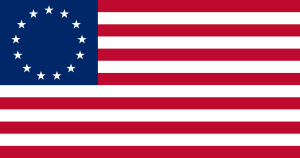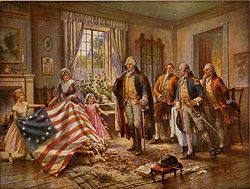Difference between revisions of "Betsy Ross" - New World Encyclopedia
Laura Brooks (talk | contribs) (import, credit, version number) |
m ({{Contracted}}) |
||
| Line 1: | Line 1: | ||
| + | {{Contracted}} | ||
:''For the lieutenant governor of New York, see [[Betsy McCaughey Ross]].'' | :''For the lieutenant governor of New York, see [[Betsy McCaughey Ross]].'' | ||
Revision as of 21:14, 27 September 2006
- For the lieutenant governor of New York, see Betsy McCaughey Ross.
Betsy Ross (January 1, 1752 - January 30, 1836) was an American woman who is said to have sewn the first American flag.
Early years
Born Elizabeth ("Betsy") Griscom in Philadelphia, Pennsylvania (some believe in Collingswood, New Jersey), she was the eighth of 17 children of Samuel and Rebecca Griscom, who were members of the Religious Society of Friends (Quakers) (her father was a master builder). Betsy attended Friends schools, where she learned reading, writing and a trade (probably sewing).
First marriage
While working as an apprentice upholsterer, she fell in love with another apprentice, John Ross, who was the son of a rector at Christ Church Pennsylvania and was a member of the Episcopal clergy. As the Quakers disapproved strongly of interdenominational marriages, like her mother and father, the couple eloped in 1773 across the Delaware River to New Jersey, where they were married by William Franklin, Benjamin Franklin's son. The couple were subsequently disowned by her Quaker meeting.
Less than two years later, they started their own upholstering business. However, their business was badly affected by the American Revolution, with fabric being hard to obtain and business slow. John joined the Pennsylvania militia and was mortally wounded in a gunpowder explosion in 1776, after which Betsy took full charge of the upholstering business.

Legend of sewing the first flag
According to legend, in June 1776, she received a visit from George Washington, George Ross and Robert Morris of the Continental Congress. She had met Washington through their mutual worship at Christ Church (and she had sewn buttons for him previously), and George Ross was John's uncle. Although there is no record of any such committee, the three men supposedly announced they were a "Committee of Three" (perhaps self-appointed, under the circumstances) and showed her a suggested design that was drawn up by Washington in pencil. The design had six-pointed stars, and Betsy, the family story goes, suggested five-pointed stars instead because she could make a five-pointed star in one snip. The flag was sewn by Betsy in her parlor. The flag was flown when the Declaration of Independence was read aloud at Independence Hall on July 8, 1776.
No contemporary record of this meeting was made. No "Betsy Ross flag" of thirteen stars in a circle exists from 1776. Historians have found at least 17 other flag makers in Philadelphia at the time. The Betsy Ross story is based solely on oral affidavits from her daughter and other relatives and made public in 1870 by her grandson, William J. Canby, in a paper read before the Historical Society of Pennsylvania. No primary sources of the time—letters, journals, diaries, newspaper articles, official records, or business records—have surfaced since 1870 confirming or disproving the story. The only further supporting documentation that Betsy Ross was involved in federal flag design is the Pennsylvania State Navy Board commissioning her for work in making "ships colors & c." in May 1777.
Some historians believe it was Francis Hopkinson and not Betsy Ross who designed the official "first flag" of the United States (13 red and white stripes with 13 stars in a circle on a field of blue). Hopkinson was a member of the Continental Congress, a heraldist, a designer of the Great Seal of the State of New Jersey, one of the designers of the Great Seal of the United States (which contains a blue shield with 13 diagonal red and white stripes and 13 five-pointed stars) and a signer of the United States Declaration of Independence. [1]
Subsequent career
After John's death, Betsy joined the "Fighting Quakers" which, unlike traditional Quakers, supported the war effort. In June 1777, she married sea captain Joseph Ashburn at Old Swedes Church in Philadelphia.
Collateral evidence to the claim that Betsy indeed provided significant design input in the flag is provided by reference to Ashburn's family coat of arms. The Ashburn crest provides a stars and bars motif not unlike Old Glory itself.[2]
British soldiers forcibly occupied their house when they controlled the city in 1777.
The couple had two daughters together. Captain Ashburn was captured by the British on a trip to procure supplies and was sent to Old Mill Prison, where he died in March 1782, several months after the surrender of General Charles Cornwallis at Yorktown.
In May 1783, she married John Claypoole, an old friend who had told her of Ashburn's death. The couple had five daughters together. He died in 1817 after 20 years of ill health. She continued working in her upholstery business until 1827. After her retirement, she moved in with her married daughter, Susannah Satterthwaite, who continued to operate the business.
Betsy Ross died in Philadelphia at age 84 and was buried at the Free Quaker burial ground. Later, her remains were removed to Mt. Moriah Cemetery, and today her remains are located in the courtyard of the Betsy Ross House. Despite being one of the three most visited tourist sites in Philadelphia, the claim that Ross once lived at her current place of rest is a matter of dispute. [3]
ReferencesISBN links support NWE through referral fees
Marc Leepson, Flag: An American Biography (Thomas Dunne Books/St. Martin's Press, 2005) [4]
- Karin A. Wulf. "Ross, Betsy"; http://www.anb.org/articles/01/01-00795.html; American National Biography Online Feb. 2000. Access Date: Thu May 12 2005 18:21:32
- See Evolution of the United States Flag for tracking the history of the Betsy Ross and Francis Hopkinson stories related to the creation of the first American flag.
External links
- USHistory.Org (Independence Hall Association) page on Betsy Ross with the highly detailed paper by William J. Canby, read before the Historical Society of Pennsylvania, 1870 on the origin of the flag, the origin of the Betsy Ross story.
- Critical analysis of the Betsy Ross story.
Credits
New World Encyclopedia writers and editors rewrote and completed the Wikipedia article in accordance with New World Encyclopedia standards. This article abides by terms of the Creative Commons CC-by-sa 3.0 License (CC-by-sa), which may be used and disseminated with proper attribution. Credit is due under the terms of this license that can reference both the New World Encyclopedia contributors and the selfless volunteer contributors of the Wikimedia Foundation. To cite this article click here for a list of acceptable citing formats.The history of earlier contributions by wikipedians is accessible to researchers here:
The history of this article since it was imported to New World Encyclopedia:
Note: Some restrictions may apply to use of individual images which are separately licensed.
